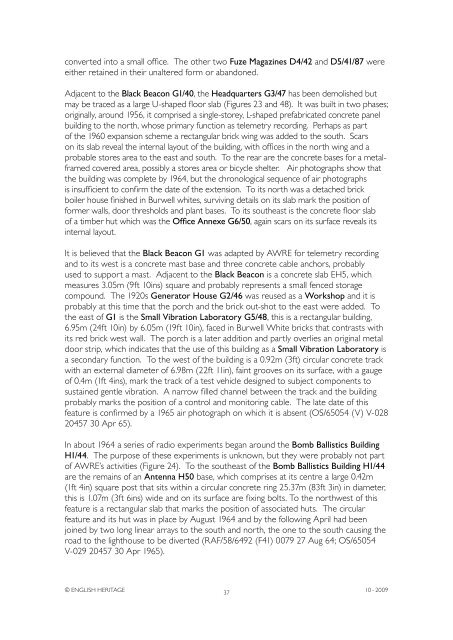Atomic Weapons Research Establishment. Orford ... - English Heritage
Atomic Weapons Research Establishment. Orford ... - English Heritage
Atomic Weapons Research Establishment. Orford ... - English Heritage
Create successful ePaper yourself
Turn your PDF publications into a flip-book with our unique Google optimized e-Paper software.
converted into a small office. The other two Fuze Magazines D4/42 and D5/41/87 were<br />
either retained in their unaltered form or abandoned.<br />
Adjacent to the Black Beacon G1/40, the Headquarters G3/47 has been demolished but<br />
may be traced as a large U-shaped floor slab (Figures 23 and 48). It was built in two phases;<br />
originally, around 1956, it comprised a single-storey, L-shaped prefabricated concrete panel<br />
building to the north, whose primary function as telemetry recording. Perhaps as part<br />
of the 1960 expansion scheme a rectangular brick wing was added to the south. Scars<br />
on its slab reveal the internal layout of the building, with offices in the north wing and a<br />
probable stores area to the east and south. To the rear are the concrete bases for a metalframed<br />
covered area, possibly a stores area or bicycle shelter. Air photographs show that<br />
the building was complete by 1964, but the chronological sequence of air photographs<br />
is insufficient to confirm the date of the extension. To its north was a detached brick<br />
boiler house finished in Burwell whites, surviving details on its slab mark the position of<br />
former walls, door thresholds and plant bases. To its southeast is the concrete floor slab<br />
of a timber hut which was the Office Annexe G6/50, again scars on its surface reveals its<br />
internal layout.<br />
It is believed that the Black Beacon G1 was adapted by AWRE for telemetry recording<br />
and to its west is a concrete mast base and three concrete cable anchors, probably<br />
used to support a mast. Adjacent to the Black Beacon is a concrete slab EH5, which<br />
measures 3.05m (9ft 10ins) square and probably represents a small fenced storage<br />
compound. The 1920s Generator House G2/46 was reused as a Workshop and it is<br />
probably at this time that the porch and the brick out-shot to the east were added. To<br />
the east of G1 is the Small Vibration Laboratory G5/48, this is a rectangular building,<br />
6.95m (24ft 10in) by 6.05m (19ft 10in), faced in Burwell White bricks that contrasts with<br />
its red brick west wall. The porch is a later addition and partly overlies an original metal<br />
door strip, which indicates that the use of this building as a Small Vibration Laboratory is<br />
a secondary function. To the west of the building is a 0.92m (3ft) circular concrete track<br />
with an external diameter of 6.98m (22ft 11in), faint grooves on its surface, with a gauge<br />
of 0.4m (1ft 4ins), mark the track of a test vehicle designed to subject components to<br />
sustained gentle vibration. A narrow filled channel between the track and the building<br />
probably marks the position of a control and monitoring cable. The late date of this<br />
feature is confirmed by a 1965 air photograph on which it is absent (OS/65054 (V) V-028<br />
20457 30 Apr 65).<br />
In about 1964 a series of radio experiments began around the Bomb Ballistics Building<br />
H1/44. The purpose of these experiments is unknown, but they were probably not part<br />
of AWRE’s activities (Figure 24). To the southeast of the Bomb Ballistics Building H1/44<br />
are the remains of an Antenna H50 base, which comprises at its centre a large 0.42m<br />
(1ft 4in) square post that sits within a circular concrete ring 25.37m (83ft 3in) in diameter,<br />
this is 1.07m (3ft 6ins) wide and on its surface are fixing bolts. To the northwest of this<br />
feature is a rectangular slab that marks the position of associated huts. The circular<br />
feature and its hut was in place by August 1964 and by the following April had been<br />
joined by two long linear arrays to the south and north, the one to the south causing the<br />
road to the lighthouse to be diverted (RAF/58/6492 (F41) 0079 27 Aug 64; OS/65054<br />
V-029 20457 30 Apr 1965).<br />
© ENGLISH HERITAGE<br />
37<br />
10 - 2009

















